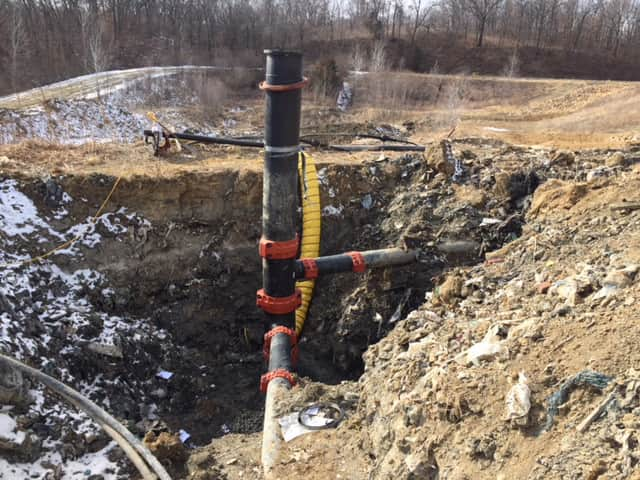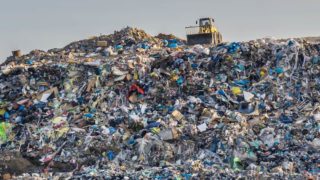Posted on April 25, 2019
Municipal solid waste landfills are the third largest source of human-related methane, a natural byproduct of the decomposition of organic material. Landfill gas is extracted using a series of vertical wells and a vacuum system and transported to the gas-to-energy plant via high-density polyethylene (HDPE) pipe before being converted into power. The St. Joseph Sanitary Landfill in St. Joseph, Missouri sells its recovered methane gas to a local public utility company, Kansas City Power and Light Company (KPC&L), where it is used to produce electricity. KCP&L closely monitors the collected methane to calculate the recovered quantities and to detect irregularities in the gas stream constituents, which can alter the methane cleaning process during the energy conversion process.
Detection of an issue
In late 2017, KCP&L noticed an increase in oxygen levels in the gas stream, which generally indicates a break in the collection system and ambient air being pulled into the gas stream. Landfill staff inspected and isolated the problem, pinpointing weaknesses in the fusion welds on the tees coming off of two of the 18-inch vertical HDPE condensate sumps. Stress from localized settling had led to fractures on the HDPE gusset welds. Blackstone Environmental, Inc., the landfill’s engineering consultant, and environmental services partner was tasked with finding a way to fix the two sumps that were both time and cost-efficient and could withstand the stress of localized settling.
Generally, HDPE landfill systems go in with premanufactured welds. In this case, the premanufactured welds on the sumps failed, likely due to settling around them, so we needed to find an HDPE solution that would stand up to the landfill environment, accommodate future settling, and could be installed efficiently.
Kyle Kukuk, P.E.
Senior Project Manager, Blackstone Environmental, Inc.
Recognizing that the repairs needed to be executed quickly but cognizant of the difficulties introduced by weather conditions (temperatures were near 0°F, with the wind chill pushing feel-like temperatures well below zero), Kukuk and his team determined the two sumps needed to be excavated and repaired in two stages.
Evaluating the options
Since one sump would remain operational while the other was repaired, Kukuk said minimizing downtime was critical. A traditional repair of the fusion welds would require extensive excavation to unearth the pump system and HDPE branch lines to expose the damaged tees, followed by electrofusing or butt fusing the line’s areas of weakness.
Kukuk explained that both in situ fusion options posed several challenges related to safety and inclement weather. Working near the flammable methane gas would require careful planning and consideration. The work area would have to be screened to protect it from wind, and specialized equipment, and a specially trained crew would need to be on site. Electrofusion is generally not reliable on lines larger than 10-inch, and butt fusion would have required heaters to be moved onsite to create an environment conducive to the fusing process.
With the timeline set for this project, Kukuk said the landfill owners were willing to consider other alternatives:
We were aware of Victaulic’s mechanical joining solutions and heard about how they had been used on other landfill projects. When looking at the cost of alternatives and additional set up that would be needed to excavate and get welders in to fix the pipe, it seemed like the perfect opportunity to try Victaulic’s HDPE couplings instead.
Taking a different path
Although mechanically joining HDPE is still a novel solution for landfills, Kukuk said there were good reasons to consider it for the St. Joseph site. Victaulic® couplings make installation easier as they are not weather-dependent and do not require special tools or a specialized crew. Mechanical couplings can also join pipe that is wet, out of round, and oxidized, which would be impossible with fusion. Additionally, the design of the couplings offers a performance advantage over fused options, which had previously failed due to stress from weight and settlement on top of the system. Victaulic’s couplings, on the other hand, could accommodate some of the load from compaction and diffuse the stress in the branches off the tees.
A backhoe excavated the pump area for the first installation, and a chainsaw was used to cut the HDPE pipe to remove the sump pump. Two 18-inch by 10-inch tees were fabricated in a shop and moved by truck to the site, where a crane lifted them into place. Victaulic Style 908 and Style 905 couplings were used to join 18-, 12-, and 10-inch lines. Even with the challenges associated with a first-time installation, the crew was able to complete the job quickly and efficiently. Two months later, the successful process was repeated to repair the second pump, resulting in an effective and affordable repair to the weaknesses in the landfill’s methane gas extraction system.
“After the Victaulic installation, KCP&L had been constantly monitoring the methane levels and had indicated that the solution was successful on both sumps,” Kukuk explains.

Another fix
In early 2019, KCP&L saw the same spike in oxygen levels, indicative of the same issue the landfill faced in 2017. Upon evaluation, landfill staff confirmed the presence of failed welds on tees coming off of an additional condensate pump. The landfill owners and Blackstone Environmental teamed up for a third time on a third pump, seeing the same success, according to Kukuk:
We’ve been very pleased with the outcome on all three pumps and are eager to see the Victaulic couplings hold up over time. Using mechanical couplings for HDPE on landfill projects, especially with larger pipe sizes, was new for us, but they not only offered a reliable fix – they provided a solution that was easy and safe to implement.
To learn more about Victaulic’s System Solution for HDPE Pipe, click here.

